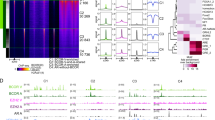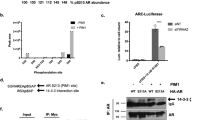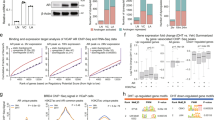Abstract
Prohibitin (PHB) is a cell cycle regulatory protein, known to repress E2F1-mediated gene activation via recruitment of transcriptional regulatory factors such as retinoblastoma and histone deacetylase 1 (HDAC1). We previously identified PHB as a target protein of androgen signaling in prostate cancer cells and showed that downregulation of PHB is required for androgen-induced cell cycle entry in these cells. We now present evidence that PHB, which has 54% homology at the protein level to the oestrogen receptor corepressor REA (repressor of oestrogen receptor activity), can repress androgen receptor (AR)-mediated transcription and androgen-dependent cell growth. Depletion of endogenous PHB resulted in an increase in expression of the androgen-regulated prostate-specific antigen gene. The repression appears to be specific to androgen and closely related receptors, as it is also evident for the glucocorticoid and progesterone, but not oestrogen, receptors. In spite of interaction of PHB with HDAC1, HDAC activity is not required for this repression. Although AR and PHB could be co-immunoprecipitated, no direct interaction was detectable, suggesting that PHB forms part of a repressive complex with the AR. Competition with the co-activator SRC1 further suggests that formation of a complex with AR, PHB and other cofactors is the mechanism by which repression is achieved. It appears then that repression of AR activity is one mechanism by which PHB inhibits androgen-dependent growth of prostate cells. Further, this study implies that the AR itself could, by mediating downregulation of a corepressor, be involved in the progression of prostate tumours to the hormone refractory stage.
This is a preview of subscription content, access via your institution
Access options
Subscribe to this journal
Receive 50 print issues and online access
$259.00 per year
only $5.18 per issue
Buy this article
- Purchase on Springer Link
- Instant access to full article PDF
Prices may be subject to local taxes which are calculated during checkout






Similar content being viewed by others
References
Adegbola O, Pasternack GR . (2005). A pp32-retinoblastoma protein complex modulates androgen receptor-mediated transcription and associates with components of the splicing machinery. Biochem Biophys Res Commun 334: 702–708.
Belandia B, Parker MG . (2003). Nuclear receptors: a rendezvous for chromatin remodeling factors. Cell 114: 277–280.
Berrevoets CA, Umar A, Trapman J, Brinkmann AO . (2004). Differential modulation of androgen receptor transcriptional activity by the nuclear receptor co-repressor (N-CoR). Biochem J 379: 731–738.
Bevan CL, Parker MG . (1999). The role of coactivators in steroid hormone action. Exp Cell Res 253: 349–356.
Brinkmann AO, Faber PW, van Rooij HCJ, Kuiper GGJM, Ris C, Klaasen P et al. (1989). The human androgen receptor: domain structure, genomic organisation and regulation of expression. J Steroid Biochem 34: 307–310.
Burd CJ, Petre CE, Moghadam H, Wilson EM, Knudsen KE . (2005). Cyclin D1 binding to the androgen receptor (AR) NH2-terminal domain inhibits activation function 2 association and reveals dual roles for AR corepression. Mol Endocrinol 19: 607–620.
Chen C, Okayama H . (1987). High efficiency transformation of mammalian cells by plasmid DNA. Mol Cell Biol 7: 2745–2752.
Cheng S, Brzostek S, Lee SR, Hollenberg AN, Balk SP . (2002). Inhibition of the dihydrotestosterone-activated androgen receptor by nuclear receptor corepressor. Mol Endocrinol 16: 1492–1501.
Coates PJ, Jamieson DJ, Smart K, Prescott AR, Hall PA . (1997). The prohibitin family of mitochondrial proteins regulate replicative lifespan. Curr Biol 7: 607–610.
Delage-Mourroux R, Martini PG, Choi I, Kraichely DM, Hoeksema J, Katzenellenbogen BS . (2000). Analysis of estrogen receptor interaction with a repressor of estrogen receptor activity (REA) and the regulation of estrogen receptor transcriptional activity by REA. J Biol Chem 275: 35848–35856.
Dubbink HJ, Hersmus R, Verma CS, van der Korput HA, Berrevoets CA, van Tol J et al. (2004). Distinct recognition modes of FXXLF and LXXLL motifs by the androgen receptor. Mol Endocrinol 18: 2132–2150.
Fusaro G, Dasgupta P, Rastogi S, Joshi B, Chellappan S . (2003). Prohibitin induces the transcriptional activity of p53 and is exported from the nucleus upon apoptotic signaling. J Biol Chem 278: 47853–47861.
Fusaro G, Wang S, Chellappan S . (2002). Differential regulation of Rb family proteins and prohibitin during camptothecin-induced apoptosis. Oncogene 21: 4539–4548.
Gamble SC, Odontiadis M, Waxman J, Westbrook JA, Dunn MJ, Wait R et al. (2004). Androgens target prohibitin to regulate proliferation of prostate cancer cells. Oncogene 23: 2996–3004.
Ho YS, Crapo JD . (1988). Isolation and characterization of complementary DNAs encoding human manganese-containing superoxide dismutase. FEBS Lett 229: 256–260.
Hu X, Lazar MA . (2000). Transcriptional repression by nuclear hormone receptors. Trends Endocrinol Metab 11: 6–10.
Hur E, Pfaff SJ, Payne ES, Gron H, Buehrer BM, Fletterick RJ . (2004). Recognition and accommodation at the androgen receptor coactivator binding interface. PLoS Biol 2: E274.
Jackson TA, Richer JK, Bain DL, Takimoto GS, Tung L, Horwitz KB . (1997). The partial agonist activity of antagonist-occupied steroid receptors is controlled by a novel hinge domain-binding coactivator L7/SPA and the corepressors N-Cor or SMRT. Mol Endocrinol 11: 693–705.
Joshi B, Ko D, Ordonez-Ercan D, Chellappan SP . (2003). A putative coiled-coil domain of prohibitin is sufficient to repress E2F1-mediated transcription and induce apoptosis. Biochem Biophys Res Commun 312: 459–466.
Kalkhoven E, Kwakkenbos-Isbrucker L, de Laat SW, van der Saag PT, van der Burg B . (1994). Synthetic progestins induce proliferation of breast tumor cell lines via the progesterone or estrogen receptor. Mol Cell Endocrinol 102: 45–52.
Kalkhoven E, Valentine JE, Heery DM, Parker MG . (1998). Isoforms of steroid receptor co-activator 1 differ in their ability to potentiate transcription by the oestrogen receptor. EMBO J 17: 232–243.
Lavinsky RM, Jepsen K, Heinzel T, Torchia J, Mullen T-M, Schiff R et al. (1998). Diverse signalling pathways modulate nuclear receptor recruitment of N-CoR and SMRT complexes. Proc Natl Acad Sci USA 95: 2920–2925.
Masiello D, Cheng S, Bubley GJ, Lu ML, Balk SP . (2002). Bicalutamide functions as an androgen receptor antagonist by assembly of a transcriptionally inactive receptor. J Biol Chem 277: 26321–26326.
McClung JK, Danner DB, Stewart DA, Smith JR, Schneider EL, Lumpkin CK et al. (1989). Isolation of a cDNA that hybrid selects antiproliferative mRNA from rat liver. Biochem Biophys Res Commun 164: 1316–1322.
Metivier R, Penot G, Hubner MR, Reid G, Brand H, Kos M et al. (2003). Estrogen receptor-alpha directs ordered, cyclical, and combinatorial recruitment of cofactors on a natural target promoter. Cell 115: 751–763.
Montano MM, Ekena K, Delage-Mourroux R, Chang W, Martini P, Katzenellenbogen B . (1999). An estrogen receptor-selective coregulator that potentiates the effectiveness of antiestrogens and represses the activity of estrogens. Proc Natl Acad Sci USA 96: 6947–6952.
Nijtmans LG, de Jong L, Artal Sanz M, Coates PJ, Berden JA, Back JW et al. (2000). Prohibitins act as a membrane-bound chaperone for the stabilization of mitochondrial proteins. EMBO J 19: 2444–2451.
Nuell MJ, Stewart DA, Walker L, Friedman V, Wood CM, Owens GA et al. (1991). Prohibitin, an evolutionarily conserved intracellular protein that blocks DNA synthesis in normal fibroblasts and HeLa cells. Mol Cell Biol 11: 1372–1381.
Rajalingam K, Wunder C, Brinkmann V, Churin Y, Hekman M, Sievers C et al. (2005). Prohibitin is required for Ras-induced Raf-MEK-ERK activation and epithelial cell migration. Nat Cell Biol 7: 837–843.
Shang Y, Myers M, Brown M . (2002). Formation of the androgen receptor transcription complex. Mol Cell 9: 601–610.
Smith CL, Nawaz Z, O'Malley BW . (1997). Coactivator and corepressor regulation agonist/antagonist activity of the mixed antiestrogen, 4-hydroxytamoxifen. Mol Endocrinol 12: 657–666.
Steglich G, Neupert W, Langer T . (1999). Prohibitins regulate membrane protein degradation by the m-AAA protease in mitochondria. Mol Cell Biol 19: 3435–3442.
Thompson WE, Branch A, Whittaker JA, Lyn D, Zilberstein M, Mayo KE et al. (2001). Characterization of prohibitin in a newly established rat ovarian granulosa cell line. Endocrinology 142: 4076–4085.
Tora L, Mullick A, Metzger D, Ponglikitmongkol M, Park I, Chambon P . (1989). The cloned human oestrogen receptor contains a mutation which alters its hormone binding properties. EMBO J 8: 1981–1986.
Verrijdt G, Schoenmakers E, Haelens A, Peeters B, Verhoeven G, Rombauts W et al. (2000). Change of specificity mutations in androgen-selective enhancers. Evidence for a role of differential DNA binding by the androgen receptor. J Biol Chem 275: 12298–12305.
Wagner BL, Norris JD, Knotts TA, Weigel NL, McDonnell DP . (1998). The nuclear corepressors NCoR and SMRT are key regulators of both ligand- and 8-bromo-cyclic AMP-dependent transcriptional activity of the human progesterone receptor. Mol Cell Biol 18: 1369–1378.
Wang L, Hsu CL, Ni J, Wang PH, Yeh S, Keng P et al. (2004a). Human checkpoint protein hRad9 functions as a negative coregulator to repress androgen receptor transactivation in prostate cancer cells. Mol Cell Biol 24: 2202–2213.
Wang S, Fusaro G, Padmanabhan J, Chellappan SP . (2002). Prohibitin co-localizes with Rb in the nucleus and recruits N-CoR and HDAC1 for transcriptional repression. Oncogene 21: 8388–8396.
Wang S, Nath N, Adlam M, Chellappan S . (1999). Prohibitin, a potential tumor suppressor, interacts with RB and regulates E2F function. Oncogene 18: 3501–3510.
Wang S, Zhang B, Faller DV . (2004b). BRG1/BRM and prohibitin are required for growth suppression by estrogen antagonists. EMBO J 23: 2293–2303.
Whitaker HC, Hanrahan S, Totty N, Gamble SC, Waxman J, Cato AC et al. (2004). Androgen receptor is targeted to distinct subcellular compartments in response to different therapeutic antiandrogens. Clin Cancer Res 10: 7392–7401.
Yeh S, Miyamoto H, Nishimura K, Kang H, Ludlow J, Hsiao P et al. (1998). Retinoblastoma, a tumor suppressor, is a coactivator for the androgen receptor in human prostate cancer DU145 cells. Biochem Biophys Res Commun 248: 361–367.
Zhang X, Jeyakumar M, Petukhov S, Bagchi M . (1998). A nuclear receptor corepressor modulates transcriptional activity of antagonist-occupied steroid hormone receptor. Mol Endocrinol 12: 513–524.
Zhou Z-X, Lane MV, Kemppainen JA, French FS, Wilson EM . (1995). Specificity of ligand-dependent androgen receptor stabilization: receptor domain interactions influence ligand dissociation and receptor stability. Mol Endocrinol 9: 208–218.
Acknowledgements
We thank Simak Ali for critical discussion and reading of the paper and Hayley Whitaker for the PHB/REA alignment. We also thank Andrew Cato for the kind gift of PC3wtAR cells and Malcolm Parker, Frank Claessens, Albert Brinkmann, Guido Jenster, Simak Ali, Marc van der Wetering and Hans Clevers for kindly providing plasmids used in this study. This work was funded by grants from the Whyte Family Charitable Trust, The Prostate Cancer Charity and the Association for International Cancer Research.
Author information
Authors and Affiliations
Corresponding author
Additional information
Supplementary Information accompanies the paper on Oncogene website (http://www.nature.com/onc).
Rights and permissions
About this article
Cite this article
Gamble, S., Chotai, D., Odontiadis, M. et al. Prohibitin, a protein downregulated by androgens, represses androgen receptor activity. Oncogene 26, 1757–1768 (2007). https://doi.org/10.1038/sj.onc.1209967
Received:
Revised:
Accepted:
Published:
Issue Date:
DOI: https://doi.org/10.1038/sj.onc.1209967
Keywords
This article is cited by
-
Targeting PHB1 to inhibit castration-resistant prostate cancer progression in vitro and in vivo
Journal of Experimental & Clinical Cancer Research (2023)
-
The CDK7 inhibitor CT7001 (Samuraciclib) targets proliferation pathways to inhibit advanced prostate cancer
British Journal of Cancer (2023)
-
Prohibitin ligands: a growing armamentarium to tackle cancers, osteoporosis, inflammatory, cardiac and neurological diseases
Cellular and Molecular Life Sciences (2020)
-
Prohibitin: a prime candidate for a pleiotropic effector that mediates sex differences in obesity, insulin resistance, and metabolic dysregulation
Biology of Sex Differences (2019)
-
Androgen receptor-modulatory microRNAs provide insight into therapy resistance and therapeutic targets in advanced prostate cancer
Oncogene (2019)



